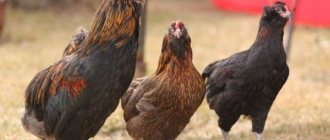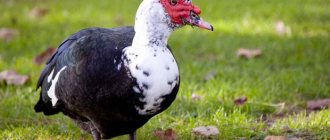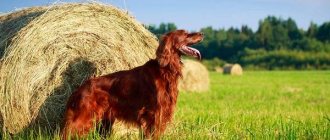Among all the variety of breeds, the naked-necked chicken looks special and even a little disgusting. She cannot be called the beauty of a private yard, and it is unlikely that the owners of this breed are guided by the goal of “pleasing their eyes.” However, despite their very unattractive appearance, these chickens are in great demand among poultry farmers, in particular due to the number of advantages that the bird offers its owner.
And in today’s publication we will present a full description of this Bare-necked bird, show its photo and publish reviews from farmers who are familiar with chickens first-hand.
History of origin
It is difficult to name the exact place of origin of this breed. However, the majority is inclined to believe that the homeland of this amazing bird is Spain, which is why the Naked-necked chicken is often called the Spanish chicken.
This miracle came to Russian territory from Romania and Hungary approximately 100 years ago.
How did such a strange breed appear? There are 2 main theories about this:
- The first says that Golosheyki became a “product” of breeding work as a result of crossing the Indian fighting breed with some other breed.
- The second theory is inclined to believe that this is simply a pathology, which subsequently began to be transmitted to a new generation.
This breed is most widespread in Transylvania, Austria and Moldova. It can also be found quite often in the southern regions of the Russian Federation.
Price and reviews of holo necks
Reviews from poultry farmers about this breed of chickens are only flattering. Moreover, this applies not only to their egg production, but also to meat. Besides. when chopping, you don’t need to pluck the bird’s neck, which also adds advantages to it compared to others.
In addition, poultry meat is very similar in taste to turkey, which allows it to be used in the preparation of dishes that require turkey meat in the recipe and, accordingly, reduces their cost, but does not reduce their taste.
In Europe, naked necks are very popular in small universal farms that sell their products to a couple of restaurants and local butcher shops. In Russia, such interaction is not yet fully developed, but is already gaining momentum.
For example, roadside restaurants and hotel complexes have been choosing to cooperate directly with local farmers for several years now. There are a couple of ways to buy birds for your farm - buy chickens or eggs for an incubator. The average price of naked chicken is from 59 to 74 rubles per egg for hatching and from 80 to 290 rubles per chicken.
You can purchase chickens using special farmer forums, sales announcements, or at agricultural fairs; the largest is held in our country in Sergiev Posad twice a year.
Description of the breed
The appearance of representatives of this breed is quite specific. The body has the usual plumage, which is typical of any other breed, but the bird’s neck is completely bare. The bird's bare neck has a bright red color, which is practically no different from the color of the beard and crest.
Chicks are born with a bare neck. Therefore, it is simply impossible to confuse the naked-necked young with any other.
Representatives of this breed have a small area of plumage on their heads that looks more like a hairstyle.
The bird's earrings are bright red, as is its comb. The hens' faces are smooth and red in color. The eyes are large, red-red in color. The beak can be either dark or light.
The bird's body is compact in size, its chest is well developed, and its belly is rounded. The wings are rather long and loosely attached to the body. The paws are powerful and strong.
Representatives of the naked-necked breed come in a wide variety of colors. Among the main ones are:
- Black.
- Belykh.
- Redhead.
- Partridges.
- Motley.
- Gray.
- Blue.
External differences between a broiler and a regular chicken
Hybrids have a number of visual and physiological differences from their egg relatives. We will consider them further.
Color
Broiler chicken is completely white, but at a younger age it is completely yellow. During plumage development, white feathers appear first at the tips of the wings. If the chicken has colored pigment spots on its body - black, red or brown, especially on the head, the scallop is most likely a representative of the egg breeds, which include the Black Moravian, Russian White and Minorca.
Meanwhile, it is impossible to accurately determine whether a chicken is a broiler type just by color, since chicks of other breeds can also be completely yellow, and as they develop, they become completely white. In this regard, it is necessary to continue further examination of the individual in order to accurately establish its species.
Body structure
By this characteristic, a broiler can be distinguished from the age of 5-7 days from birth:
- The body shape of broilers is wide and rectangular, while that of laying hens is more oval and smooth;
- broilers have a wide chest and well-developed muscles, which are especially visible on the thighs of older chickens;
- The paws of broilers are shorter than those of other breeds, but they are thicker and more stable, since they must easily withstand considerable weight;
- broiler wings are shorter than those of their relatives;
- The head of a week-old broiler looks awkwardly large relative to the proportions of the body, but over time it will become normal in shape, so the bird’s shape will become proportional.
Sexual characteristics
In broiler chickens, sexual differences have been poorly visible for quite a long time, which is due to two factors:
- cockerels and hens have poorly developed combs and beards;
- Birds do not have beautiful decorative earrings.
The fact is that hybrids are not intended for further reproduction, therefore, during selection, sexual differences were taken into account little. In chickens of egg breeds, it is much easier to establish sexual differences, since their combs and beards are well developed.
Weight
Broilers are focused on rapid weight gain, so they weigh more than laying hens, and starting from the first days of life:
- The weight of a day-old broiler is 45-50 g, and a chicken of egg breeds is 30-35 g. Some laying hens may weigh more than the standard. Most likely, they will grow up to be quite large individuals.
- On the 5th day of life, boilers significantly gain weight - their weight can exceed 100-115 g. At the same time, ordinary chickens are already significantly behind them in weight - their average weight is up to 75 g.
- On the 10th day, the weight of a broiler approaches 180-200 g, and that of a regular chick approaches 110 g.
- A month-old broiler weighs about 1 kg, and a regular individual weighs about 280 g.
You can clearly see how a broiler chicken differs from a simple chick in the following video:
Productivity
The Goloshka is a representative of universal breeds. That is, it can be kept both for the purpose of obtaining meat products and for the purpose of obtaining eggs.
Egg production rates are quite low when compared with the productivity of modern crosses. The maximum that can be squeezed out of a chicken is 150-180 eggs per year, and only under favorable housing conditions and a more or less normal diet.
Golosheki eggs are medium in size, approximately 55 to 60 grams. The shell is quite thick and creamy in color.
Despite the fact that the chickens have a bare neck, they tolerate low temperatures quite well and do not stop laying eggs in winter.
Laying hens of this breed take a long time to mature, approximately 6 months.
As for meat products, the weight of an adult rooster is in the range of 2.5-3 kg, while chickens weigh about 2-2.5 kg. The meat itself tastes like turkey.
Breeding naked necks
When forming a livestock, you need to take into account that there should be no more than 10 hens per 1 rooster; if there are more, not all eggs will be fertilized. This is not important if the bird is kept only to obtain eggs for food, but if chickens are needed, this norm must be adhered to.
As many poultry farmers note, bare-necked chickens are reluctant to sit on eggs and, knowing this feature of birds, the owners do not place eggs under the hens, but use a small home incubator.
To lay it in, you need to select the best material - eggs that are uniform in size, without cracks or stains on the shell, and as fresh as possible. It is advisable to fill the incubator tray completely to ensure the correct temperature and humidity conditions. The duration of incubation, like other chicken breeds, is 21 days.
Advantages and disadvantages of the breed
Many poultry farmers have different attitudes towards this bird. Very often people refuse to grow Holoshecks only because they are supposedly scary and cause some kind of disgust. In this case, the positive qualities of the bird are completely ignored. Nevertheless, despite its inexpressive appearance, the chicken is quite promising and has something to surprise poultry farmers. The main advantages of the breed include:
- Good taste of meat products.
- Friendly, calm and non-conflict character. Chickens get along well in a flock and are friendly with representatives of other breeds, as well as with smaller and larger poultry (geese, quail, pigeons, etc.).
- Chickens practically do not care in what conditions they are kept.
- Due to the fact that chickens do not have feathers on their necks, they are protected from parasites that mainly settle on the neck and crop of representatives of other breeds.
- Representatives of this breed are much easier to pluck.
- Chickens are equally well adapted to both heat and cold.
- Eggs have a high fertility rate. If the rooster is good, approximately 94 chicks will hatch from 100 eggs.
- A bald crop allows poultry farmers to know whether the bird has consumed enough feed or, conversely, whether it has been overfed. This allows you to properly plan the chicken’s diet.
As you can see, there are quite a lot of advantages. But chickens also have their downsides. The main negative aspects of Golosheyka include:
- It has a rather unattractive appearance, which is why many poultry farmers are disdainful of raising the breed, even without assessing its positive qualities.
- Holoshecks produce a fairly small number of eggs.
- Laying hens have a very poorly developed brooding instinct. No, they sit on nests quite often, but the problem is that chickens are the kind of species that get bored of it very quickly. For this reason, most often Goloshek is grown in incubators, and not in natural conditions.
Reviews
Bare-necked chickens are raised quite productively and often, so there are plenty of reviews about the breed.
They all boil down to the following advantages:
- Good survival rate of young animals - 95% is considered the norm.
- Excellent taste of meat and easier plucking process due to the absence of feathers on some parts of the body.
- Early egg laying, and hens continue to lay eggs even in December and January.
- Good productivity of laying hens - but this point is controversial for many, since the priorities of each bird owner are different.
- Pickiness and endurance, even at sub-zero temperatures.
- Good presentation of eggs.
There is basically only one minus, and it is quite subjective - the unsightly appearance of the birds.
Care and maintenance
In order for the chickens to have a good time, it is necessary to create optimal living conditions for them.
First of all, they pay attention to the chicken coop, since this is where the chickens will spend the night and spend all their time during the winter season.
The chicken coop should be dry, warm and well lit.
There should be no drafts in it, which could cause the development of diseases in the bird. But at the same time, it should not be a “closed box” in which there is no ventilation at all. It is necessary not only to ensure that the chickens receive fresh air, but also to remove unpleasant odors, in particular those formed due to poultry waste.
The floor is covered with a special bedding that will keep the room warm and also absorb all the moisture. The most commonly used flooring materials are:
- Straw.
- Hay.
- Peat.
- Sawdust.
The height of the litter should be at least 15 cm.
The chicken coop should also have drinking bowls, feeders and a container with wood ash. Wood ash is necessary for birds to clean their feathers and get rid of parasites such as fleas and ticks.
Water in drinking bowls should always be clean and available 24 hours a day. In summer it is changed twice a day, in winter - once a day. Also, periodically, as they become dirty, the drinking bowls are washed.
To prevent birds from knocking over feeders, they are placed along the wall. Also, in order to protect them from the paws of chickens (who like to squirm around in water and feed) and from their droppings, special nets are installed on drinking bowls, which do not restrict the bird’s access to provisions, but protect it from scattering and droppings.
Another important attribute is nests and perches. Nests are placed at a height of 50-60 cm from the floor. It is advisable to place them in shaded places that are convenient for collecting eggs. The ideal dimensions of the nests are 40x40 cm.
As for perches, they are built at the rate of 20 cm per individual. In this case, the distance between the perches should be at least 35 cm. The perches are built at a height of 50-60 cm from the floor on the opposite side of the chicken coop window.
The premises are periodically disinfected. Ideally – once every six months. Disinfection is necessary primarily to combat parasites such as fleas and ticks, which pose a serious problem not only for chickens, but also for the owner who enters the chicken coop to clean it or collect eggs.
We recommend reading: Description of the Wyandotte chicken breed
Important attention is paid to daylight hours. In winter, daylight hours become shorter, which requires artificial extension. Otherwise, the chickens will lay eggs even worse (and we remember that their productivity is not the highest anyway). Extend daylight hours using regular yellow incandescent lamps. The standard length of daylight, regardless of the age of the bird, is 15-16 hours.
Features of breeding chicks
Bare-necked chickens are not bred on an industrial scale, but they can often be found in private backyards. The breed does not require special growing conditions; corydalis feel good both in closed chicken coops and poultry houses with the possibility of walking in the fresh air. When raising young animals, the incubation method is preferable. As hens, bare-necked hens have not proven themselves to be the best: in the middle of the brooding period, the hen may leave the nest with eggs.
An important criterion is also the appearance of the eggs: the best material for hatching will be clean, without visible flaws, eggs of the same size. It is better not to take small eggs: they usually hatch into weak chicks. If possible, it is advisable to examine the incubation material with an ovoscope to identify defects. There is no need to wash the eggs before laying them.
The temperature in the room where the incubator is located should be at least 15°C (optimal - 20-22). It is better to lay the incubation material in the evening, in this case there is a high probability that hatching will begin in the morning and not at night.
The temperature in the apparatus itself is regulated depending on the incubation stage:
- Initial (1-11 days). The incubator is set at 38-39°C and 30°C humidity. The eggs should be turned every 2-3 hours (to avoid getting lost, it is convenient to put marks on them (plus or minus, tic-tac-toe). From the 4th day, airing of the incubation material begins.
- Intermediate (12-19 days). The temperature is reduced by 0.5 degrees, and the humidity by 2 values. It is important that during ventilation the temperature is below the permissible value for this stage for no more than half an hour.
- Final (19-21 days). At this stage, the ventilation ducts open completely, the temperature drops by another 0.5 degrees, and the humidity is brought to 31°C. There is no need to turn and air the eggs anymore.
Chicken diet
There are no special requirements for the diet of Golosheykas. However, the more balanced the diet, the faster the chickens will gain weight, the stronger their immunity will be and the higher their egg production rates. Poultry farmers recommend including in the diet:
- Fresh grass.
- Vegetables. They can be given either fresh or added to mash.
- Cereals. They should form the basis of the diet. Cereals are given both whole and ground. It is also recommended to give the bird sprouted grain, as its consumption stimulates an improvement in egg production.
- Sources of calcium. The most common sources of calcium are: chalk, crushed shell rock, crushed eggshells. The ideal option is crushed shell rock. Eggshells are dangerous because a chicken can recognize them as eggs. If this happens, there is a high probability that the chickens will begin to peck at their own eggs to obtain calcium. As for chalk, it is often prohibited to give it to birds, as it can stick together in the stomach, thereby causing blockage of the gastrointestinal tract.
- Mash. It is advisable to give them at lunch. The mash is distinguished by the fact that it contains a large amount of useful substances. You can add cereals, vegetables, bone meal, salt, etc. to the mash. In addition, they can be cooked in meat broth.
- Yeast. They are necessary when you need to accelerate weight gain.
Chickens are fed three or four times a day. In the summer, it is advisable to give the chickens dry food, and in the winter, the emphasis is on mash.
What to feed?
Owners who are just starting to get acquainted with callos need not worry about what to feed this strange bird. She is unpretentious in food, and you can feed her the same as ordinary chickens: grains, vegetables, dairy products, clover. Laying hens should also be fed sprouted grain. It would be a good idea to include vegetables in their diet. Thus, the bird will receive the necessary nutrients.
Digestion of naked necks has its own characteristics. Sand is an excellent food supplement for them. It is also advisable to add corn, yeast, ground eggshells (it contains the necessary calcium) and chalk to the birds’ diet.
Birds do not neglect feed, but the owner must understand that only balanced feed will give chickens all the necessary vitamins and microelements. The daily food requirement for an adult weighing 2 kg is 130 g. For every subsequent 250 g of the neck's weight, there is 10 g of feed additive. The presence of water in the feeder must be constant.
Feeding and keeping chickens
Naked chicks are born quite vulnerable to environmental conditions. Therefore, it is very important to maintain optimal conditions for keeping and feeding chickens:
- After birth and until 5 days of age, chickens are kept at a temperature of +30 degrees Celsius.
- From the 6th day of life to the 9th day of life, the temperature is lowered by 2 degrees, bringing it to +28 degrees Celsius.
- Then, over the course of 4 days, the temperature is lowered by another 2 degrees, bringing it to +26 degrees Celsius.
- Then the temperature is lowered daily, dropping it to +18 degrees Celsius.
The young animals are fed either starter feed or boiled egg whites. Gradually, fresh cottage cheese and fresh grass are introduced into the diet. Until the 10-day period of life, young animals are fed every 2 hours, 6 times a day. From the second month of life, the bird can already be given coarser food, such as whole corn.
To strengthen the body, young animals can be given fish oil and chalk.
Chick care
The hatchability of bare-necked chickens is good, there is almost no mortality. Adult hens, although not laying eggs, can raise chicks and do so responsibly. You can raise babies separately from adults.
The chickens will need to set up a brooder and hang a red lamp over it for lighting and heating. At first they are kept warm, at a temperature above 25°C, after they reach 1 month it is reduced to 15-20°C.
The diet of babies differs from the menu of adult chickens. In the first 2 days they eat only a boiled, finely chopped egg, then non-acidic cottage cheese can be added to it (1 to 1), on the 3rd day - greens: parsley or dill, chopped grain from corn, wheat or oats.
You need to add grated boiled carrots to the mixture, if there are no greens - herbal flour (2-3 g per head), vitamins A, E and D in an oil solution and fish oil (2 times a week, 1 tsp per 1 kg feed), curdled milk, whey, fresh milk.
Feed is given to small chickens by pouring it onto a thin board, which is placed under a red lamp. A drinking bowl with clean, chlorine-free water is installed next to it. You can put several crystals of potassium permanganate in it so that the liquid turns light pink, this will prevent chickens from dying from gastric disorders. The frequency of feeding should initially be high - up to 5-6 times a day (the first 2 weeks), by the 4th week the feed should be reduced to 3 times.
Week-old naked chicks are fed a mash of eggs, chaff, boiled root vegetables (carrots, potatoes), and greens. Take all components in approximately equal shares. Food should be crumbly, not dry, but not liquid. 10-day-old chickens are fed the same food, but without eggs, with the addition of oil cake (3-4%), bone meal (2-3 g per head), a small amount of chalk, and from 2 weeks, salt.
At this age, bran (10% of the feed) can be introduced into their diet. 3-week-old chickens are already allowed to be fed whole grains and split peas. You should not give spoiled, rotten vegetables, rotten grain and grass. Young animals should eat about 15-30 g of food per day. After each distribution, the remains from the feeders must be removed so as not to sour, rinse them with water and dry them.
Feeding adults
You can feed barenecks the same as other chickens, that is, grain, waste from its production, root vegetables, chopped grass, vegetables and fruit drops, add bone meal, fish meal, yeast, mineral supplements and salt.
In order for food to be digested normally, they should always have coarse sand and small stones in the chicken coop. The presence of clean fresh water is mandatory; it must be changed every day.
Bare-necked laying hens can eat grain, whole, crushed, sprouted, or wet mash. It is optimal to give them mash in the morning and grain in the evening. In addition to grain - the basis of the diet - you need to add grass, tops, grated vegetables, potato tubers, weeded weeds and definitely legumes - grain or greens (peas and beans, alfalfa, sainfoin and vetch) to the mash.
In spring you can cut nettles, dandelions, burdocks, and wheatgrass. Laying hens need calcium to form shells, so don’t forget to add chalk to the mash. One individual weighing 2 kg per day should eat 130-150 g of food. This is an approximate norm, but if chickens eat more, then you should not limit their food.
Bare-necked broiler chickens can also eat grain and grass, but they can be fed with ready-made mixed feed, this is very convenient - you don’t need to prepare mixtures every day, monitor whether they are fresh or not, or calculate the volume of ingredients.
A good feed contains all the substances that chickens require; their combination and proportions are correctly selected. You need to give dry feed in plenty, it should always be in the feeders, when using it, you need to remember that the chickens should have free access to water. Already at 4 months of age, broilers on this diet can be slaughtered for meat.
According to reviews from many poultry farmers who have barenecks on their farms, this is a good breed, it is profitable to keep it, and there are almost no problems with chickens. Those who doubt whether to keep this bird because of its original appearance need to pay attention to its attractive characteristics.
If you enter the query “turkey-chicken hybrid” into a search service, the search engine will probably return photos of chickens with a bare red neck, similar to the neck of an angry turkey. Not actually a hybrid in the photo. This is a bare-necked breed of chicken that appeared as a result of mutation.
The breed is believed to originate from Transylvania. But this opinion is controversial, since they have only just begun to spread across Europe from Romania and Hungary. In these countries they were called Semigrad Golosheks. Spain, more precisely, Andalusia, also claims to be the author of the breed. Bare-necked Transylvanian (Spanish) chickens are especially common in Germany and France. France has already developed its own breed, which is not related to the Transylvanian bare-necked chickens. However, holo-necks are very rare in England and unknown in the USA.
The name is formed from the traditional compilation of the names of the parent species for hybrids. It took root due to confusion when genetic research was not yet developed and it was believed that the bare-necked chicken was a hybrid of a turkey and a chicken. In fact, the North American turkey does not interbreed with any species of pheasant, and the naked-necked fowl is a purebred bird belonging to the banker fowl species.
Although the breed is not found in the United States, the American Poultry Association recognized it in 1965. The bare-necked chicken was first shown in Great Britain in 1920. In the CIS, the Transylvanian (or Spanish) version of bare-necked chickens is bred.
The photo shows bare-necked roosters. On the left is a Spanish bareneck, on the right is a French nakedneck.
Compared to the French version, Spanish chickens more closely resemble an angry turkey.
Selection of bare-necked chicks
Rhode Island Chickens
When buying chickens of the French or Spanish breed, the first thing you need to pay attention to is the body. If it is underdeveloped, this is the first sign of disease in birds. What else to pay attention to:
- Legs shouldn't be weak.
- If the eyes are dark in color, this also indicates the presence of the disease.
- If feather cover is found in the apterial zones (where it should not be), this is not an acceptable norm for the bird.
- Yellowing of bare areas is also a sign of the disease.
It is worth noting that bare-necked chickens have excellent endurance. Approximately 95% of the young survive.
Selection of bare-necked chicks











